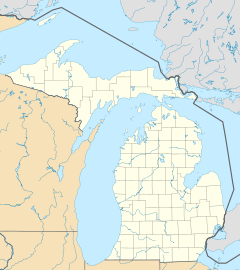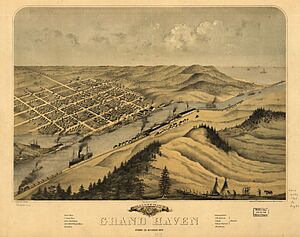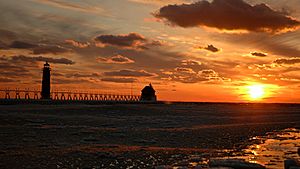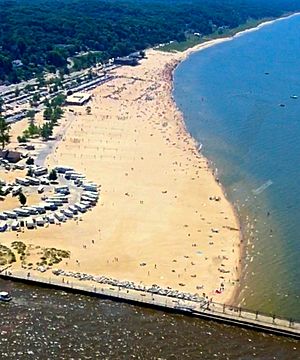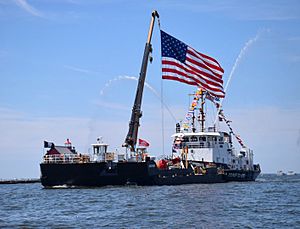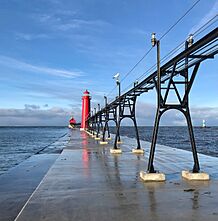Grand Haven, Michigan facts for kids
Quick facts for kids
Grand Haven, Michigan
|
|
|---|---|
| City of Grand Haven | |
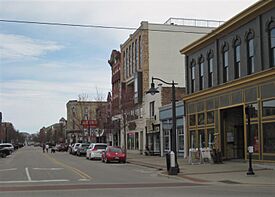
Downtown along Washington Avenue
|
|
| Nickname(s):
Coast Guard City USA
|
|

Location within Ottawa County
|
|
| Country | United States |
| State | Michigan |
| County | Ottawa |
| Settled | 1833 |
| Incorporated | 1867 |
| Government | |
| • Type | Council–manager |
| Area | |
| • Total | 6.25 sq mi (16.19 km2) |
| • Land | 5.72 sq mi (14.83 km2) |
| • Water | 0.53 sq mi (1.37 km2) |
| Elevation | 662 ft (202 m) |
| Population
(2020)
|
|
| • Total | 11,011 |
| • Density | 4,562.9/sq mi (1,761.76/km2) |
| Time zone | UTC-5 (EST) |
| • Summer (DST) | UTC-4 (EDT) |
| ZIP code(s) |
49417
|
| Area code(s) | 616 |
| FIPS code | 26-33340 |
| GNIS ID | 0627084 |
Grand Haven is a city in the state of Michigan, USA. It is the main city of Ottawa County. Grand Haven is located on the eastern shore of Lake Michigan. It sits where the Grand River flows into the lake, which is how it got its name.
In 2020, about 11,011 people lived in Grand Haven. The city has its own airport, the Grand Haven Memorial Airpark. It is just north of Grand Haven Charter Township.
Contents
History of Grand Haven
Long ago, the Potawatomi and Ottawa Native American tribes lived in this area. They used the Grand River for trading goods. We are still learning about their ancient cultures from things found by archaeologists.
European settlers, especially the French, started coming to the area later. A place for trading animal furs, called Gabagouache, was set up by Madeline La Framboise and her husband.
After the War of 1812, more Americans moved here. A trading post was opened around 1821. The first person to live here permanently was William Montague Ferry, a minister. He started the first church in 1834. In 1835, a settler named Rix Robinson gave the town its name, "Grand Haven."
Over time, more businesses started. A tannery (a place that makes leather) was founded in 1838. The city's first bank opened in 1851. William Montague Ferry also started a school, Ferry Elementary, which is still open today. Grand Haven officially became a city in 1867.
In the mid-to-late 1800s, Grand Haven became important for cutting down trees, making lumber, and shipping goods. It was also a place where ships were built.
The city had a train line called the Grand Trunk Railway that ran along the river. The old train station is now a history museum. A company called Story and Clark Piano Company made pianos here from 1900 to 1984.
The Grand Haven Lighthouses were built in 1839 to help ships find their way into the river. The red lighthouses you see today were built in 1875 and 1905. They are connected by a walkway that goes out to the shore.
In the 1930s, a bank in Grand Haven was robbed. This event was part of a historical period when such crimes sometimes happened.
Geography and Climate
Grand Haven covers about 7.36 square miles (19.06 square kilometers). Most of this area is land, and a smaller part is water.
Grand Haven's Climate
Grand Haven has a climate with warm summers and cold winters. This is called a "warm-summer humid continental climate." The hottest temperature ever recorded in Grand Haven was 98°F (37°C) on June 4, 2023. The coldest was -13°F (-25°C) on February 20, 2015. Winters here are usually warmer than in cities on the western side of Lake Michigan.
| Climate data for Grand Haven, Michigan, 1991–2020 normals, extremes 2008–present | |||||||||||||
|---|---|---|---|---|---|---|---|---|---|---|---|---|---|
| Month | Jan | Feb | Mar | Apr | May | Jun | Jul | Aug | Sep | Oct | Nov | Dec | Year |
| Record high °F (°C) | 63 (17) |
63 (17) |
82 (28) |
80 (27) |
95 (35) |
98 (37) |
96 (36) |
93 (34) |
92 (33) |
83 (28) |
73 (23) |
65 (18) |
98 (37) |
| Mean daily maximum °F (°C) | 31.7 (−0.2) |
33.2 (0.7) |
42.4 (5.8) |
54.7 (12.6) |
67.1 (19.5) |
76.4 (24.7) |
80.0 (26.7) |
78.9 (26.1) |
72.9 (22.7) |
60.0 (15.6) |
46.7 (8.2) |
36.5 (2.5) |
56.7 (13.7) |
| Daily mean °F (°C) | 25.5 (−3.6) |
26.4 (−3.1) |
34.0 (1.1) |
45.3 (7.4) |
57.0 (13.9) |
66.7 (19.3) |
71.0 (21.7) |
69.4 (20.8) |
62.7 (17.1) |
51.3 (10.7) |
39.8 (4.3) |
30.9 (−0.6) |
48.3 (9.1) |
| Mean daily minimum °F (°C) | 19.3 (−7.1) |
19.5 (−6.9) |
25.5 (−3.6) |
35.8 (2.1) |
46.9 (8.3) |
56.9 (13.8) |
61.9 (16.6) |
59.8 (15.4) |
52.5 (11.4) |
42.5 (5.8) |
32.8 (0.4) |
25.2 (−3.8) |
39.9 (4.4) |
| Record low °F (°C) | −9 (−23) |
−13 (−25) |
−9 (−23) |
15 (−9) |
27 (−3) |
40 (4) |
44 (7) |
41 (5) |
38 (3) |
26 (−3) |
16 (−9) |
6 (−14) |
−13 (−25) |
| Average precipitation inches (mm) | 2.84 (72) |
2.00 (51) |
2.27 (58) |
3.71 (94) |
3.81 (97) |
3.54 (90) |
3.62 (92) |
3.13 (80) |
3.45 (88) |
3.75 (95) |
3.08 (78) |
2.44 (62) |
37.64 (957) |
| Source 1: NOAA | |||||||||||||
| Source 2: National Weather Service | |||||||||||||
Population of Grand Haven
| Historical population | |||
|---|---|---|---|
| Census | Pop. | %± | |
| 1870 | 3,147 | — | |
| 1880 | 4,862 | 54.5% | |
| 1890 | 5,028 | 3.4% | |
| 1900 | 4,743 | −5.7% | |
| 1910 | 5,856 | 23.5% | |
| 1920 | 7,205 | 23.0% | |
| 1930 | 8,345 | 15.8% | |
| 1940 | 8,799 | 5.4% | |
| 1950 | 9,536 | 8.4% | |
| 1960 | 11,066 | 16.0% | |
| 1970 | 11,844 | 7.0% | |
| 1980 | 11,763 | −0.7% | |
| 1990 | 11,951 | 1.6% | |
| 2000 | 11,168 | −6.6% | |
| 2010 | 10,412 | −6.8% | |
| 2020 | 11,011 | 5.8% | |
| U.S. Decennial Census | |||
Grand Haven is part of the larger Grand Rapids Metropolitan Area. This area had over 1 million people in 2014.
In 2010, there were 10,412 people living in Grand Haven. Most residents were White (95%). A small number of people were African American, Native American, or Asian. About 2.4% of the population was Hispanic or Latino.
Fun Things to Do in Grand Haven
Grand Haven is a popular place for tourists, especially in summer. It has many fun activities like boating, fishing, sailing, biking, and skating. There are also campgrounds and parks. The city has over 100 miles (160 km) of bike trails.
You can visit the state beach, walk along the boardwalk, and see the two lighthouses and the pier. Many people from other parts of Michigan come to Grand Haven to enjoy Lake Michigan's beaches.
Grand Haven State Park has beaches where the water can get warm enough for swimming in summer. This brings many visitors and helps the local businesses. The state park also has a campground right on Lake Michigan.
Grand Haven also has a ski park called Mulligan's Hollow Ski Bowl and a skate park. The waterfront is great for boating, jet skiing, and windsurfing.
Coast Guard City, USA
Grand Haven is known as "Coast Guard City, USA." The United States Coast Guard has a base here. The first Coast Guard presence was in 1924.
During Second World War, a Coast Guard ship called the Escanaba was based in Grand Haven. After it sank, the people of Grand Haven helped raise money to build a new ship with the same name. Some parts of the original Escanaba are still displayed on the city's waterfront.
Grand Haven hosts the yearly Coast Guard Festival. This celebration honors the Coast Guard and brings many ships, parades, and activities. Over 300,000 people visit for this festival every year. Grand Haven was the first city to be officially named "Coast Guard City, USA" by the U.S. Congress in 1998.
Musical Fountain and Museums
The Grand Haven Musical Fountain was built in 1962. It is on the other side of the Grand River from the city center. It plays music and light shows every night during the tourist season. When it was built, it was the largest musical fountain in the world.
Grand Haven is also home to the Midwest Miniatures Museum. It is in an old mansion downtown and shows many tiny, detailed models made by famous artists.
The city has many parks, including a large beach area on Lake Michigan. Duncan Woods is a big area of untouched forest. Here, visitors can see what Michigan looked like before many trees were cut down.
Technology in Grand Haven
Grand Haven has been a leader in technology. It has been featured in national news and magazines like PCWorld and Forbes. The city was the first in the country to offer citywide wireless internet service. This service works throughout the city and even up to 15 miles (24 km) offshore for boaters. Since 2004, the city has offered wireless internet for residents, businesses, and visitors.
Schools in Grand Haven
Grand Haven has several public schools:
- Grand Haven High School
- Central High School
- White Pines Intermediate School
- Lakeshore Middle School
- Voyagers School
- Rosy Mound Elementary
- Robinson Elementary
- Peach Plains Elementary
- Mary A. White Elementary
- Lake Hills Elementary
- Griffin Elementary
- Ferry Elementary
There are also private schools:
- Grand Haven Christian School
- St. John's Lutheran School
Transportation
Highways
 US 31 goes through Grand Haven. It uses a bridge that lifts up over the Grand River.
US 31 goes through Grand Haven. It uses a bridge that lifts up over the Grand River.- M-104 runs east from US 31 towards I-96.
Media
The local daily newspaper is the Grand Haven Tribune. The city also has several radio stations, including WGHN (AM), WGHN-FM, WMPA, Oldies 94.9, and WAWL.
Famous People from Grand Haven
- Howard Bailey, a professional baseball pitcher.
- Neal Ball, the first baseball player to make an "unassisted triple play" in 1909.
- BØRNS, an indie-pop singer-songwriter.
- Dan Bylsma, a former professional hockey player and coach who won the Stanley Cup as a coach.
- John Engler, who was Michigan's 46th Governor.
- Thomas W. Ferry, a U.S. Senator.
- William Montague Ferry, a minister and community leader who helped start many settlements in Ottawa County.
- Mike Teeter, a former professional football player.
See also
 In Spanish: Grand Haven para niños
In Spanish: Grand Haven para niños


